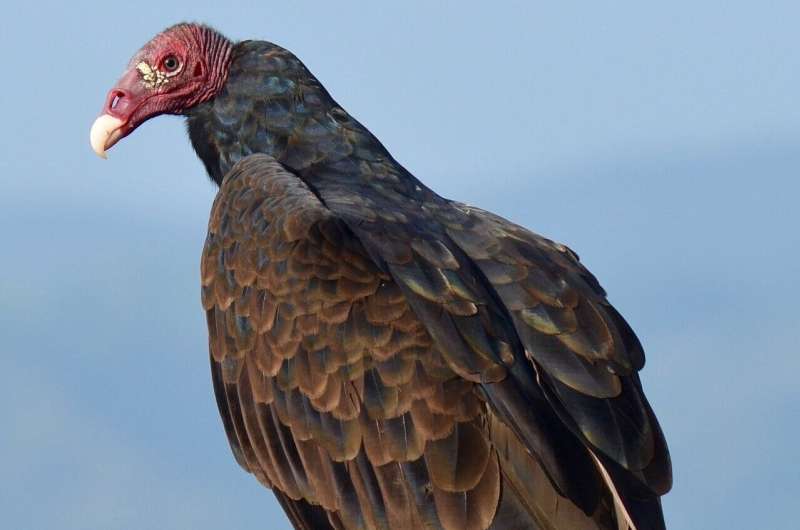This article has been reviewed according to Science X's editorial process and policies. Editors have highlighted the following attributes while ensuring the content's credibility:
fact-checked
peer-reviewed publication
trusted source
proofread
How large turkey vultures remain aloft in thin air

Mountain hikes are invigorating. Crisp air and clear views can refresh the soul, but thin air presents an additional challenge for high-altitude birds. "All else being equal, bird wings produce less lift in low density air," says Jonathan Rader from the University of North Carolina (UNC) at Chapel Hill, U.S., making it more difficult to remain aloft.
Yet this doesn't seem to put them off. Bar-headed geese, cranes and bar-tailed godwits have recorded altitude records of 6,000 m and more. So how do they manage to take to the air when thin air offers little lift? One possibility was that birds at high altitude simply fly faster, to compensate for the lower air density, but it wasn't clear whether birds that naturally inhabit a wide range of altitudes, from sea level to the loftiest summits, might fine-tune their flight speed to compensate for thin air.
"Turkey vultures are common throughout North America and inhabit an elevation range of more than 3,000 m," says Rader, so he and Ty Hedrick (UNC-Chapel Hill) decided to find out whether turkey vultures (Cathartes aura) residing at different elevations fly at different speeds depending on their altitude.
They publish the discovery in Journal of Experimental Biology that turkey vultures fly faster at altitude to compensate for the lack of lift caused by flying in thin air.
First the duo needed to select locations over several thousand meters' altitude, so they started filming the vultures flying at the local Orange County refuse site (80 m above sea level). "Vultures on a landfill… who would have guessed?", chuckles Rader.
Then they relocated to Rader's home state of Wyoming, visiting Alcova (1600 m) before ending up at the University of Wyoming campus in Laramie (2200 m).
At each location, the duo set up three synchronized cameras with a clear view of a tree that was home to a roosting colony of turkey vultures, ready to film the vultures' flights in 3D as they flew home at the end of the day.
"Wyoming is a famously windy place and prone to afternoon thunderstorms," Rader explains, recalling being chased off the roof of the University of Wyoming Biological Sciences Building by storms and the wind blurring movies of the flying birds as it rattled the cameras.
Back in North Carolina, Rader reconstructed 2,458 bird flights from the movies, calculating their flight speed before converting to airspeed, which ranged from 8.7 to 13.24m/s. He also calculated the air density at each location, based on local air pressure readings, recording a 27% change from 0.89kg/m3 at Laramie to 1.227 kg/m3 at Chapel Hill.
After plotting the air densities at the time of flight against the birds' airspeeds on a graph, Rader and Hedrick could see that the birds flying at 2,200m in Laramie were generally flying ~1m/s faster than the birds in Chapel Hill. Turkey vultures fly faster at higher altitudes to remain aloft. But how do they achieve these higher airspeeds?
Rader returned to the flight movies, looking for the tell-tale up-and-down motion that would indicate when they were flapping. However, when he compared how much each bird was flapping with the different air densities, the high-altitude vultures were flapping no more than the birds nearer to sea level, so they weren't changing their wingbeats to counteract the effects of low air density.
Instead, it is likely that the 2,200 m high birds were flying faster simply because there is less drag in thin air to slow them down, allowing the Laramie vultures to fly faster than the Chapel Hill birds to compensate for generating less lift in lower air density.
More information: Turkey vultures tune their airspeed to changing air density, Journal of Experimental Biology (2024). DOI: 10.1242/jeb.246828
Journal information: Journal of Experimental Biology
Provided by The Company of Biologists




















